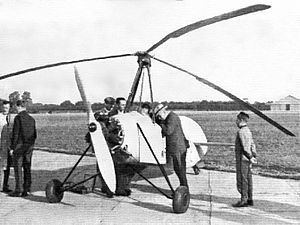Length 5.44 m | First flight February 6, 1937 | |
 | ||
The Hafner A.R.III Gyroplane was a British 1930s experimental autogyro designed by Austrian Raoul Hafner, and built by the A.R.III Construction Company at Denham, Buckinghamshire.
Contents
Design and development
The single-seat Gyroplane had a three-blade auto-rotating rotor fitted above the fuselage on a strutted plyon. A 90 hp (67 kW) Pobjoy Niagara radial piston engine was mounted on the fuselage nose. It had fixed tailwheel landing gear and the rear fuselage included a large dorsal fin to provide directional stability. An unusual feature was the control system which was equipped with spider-actuated cyclic and collective pitch control of the rotor blades; this mechanism, a variant of the swashplate-actuated rotor control, became a standard feature on helicopters. In 1935, the Gyroplane was manufactured at the Martin-Baker Aircraft Company's factory at Denham, Buckinghamshire. In autumn 1935, the Gyroplane, registered G-ADMV, first flew at Heston Aerodrome, piloted by V.H. Baker. On 6 February 1937, it flew at Hanworth Air Park, having been modified as the Mark 2 version. It was tested at Farnborough, and leased to the Royal Aircraft Establishment for research, but it was scrapped during the second world war. A two-seat A.R.IV and three-seat A.R.V were planned, but construction was stopped when Hafner was interned under Defence Regulation 18B.
Variants
Specifications
Data from British Civil Aircraft since 1919 Volume
General characteristics
Performance
